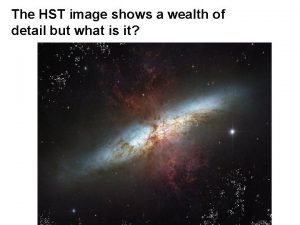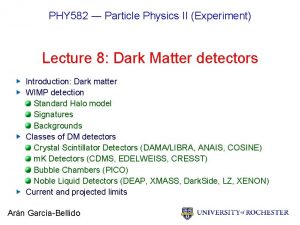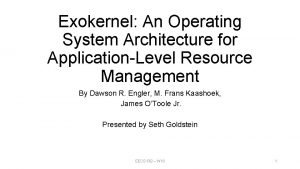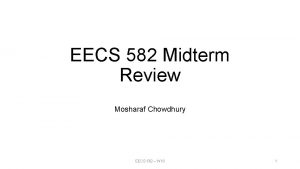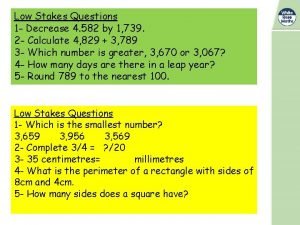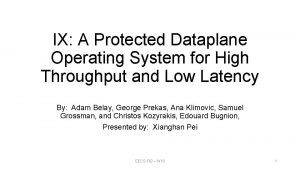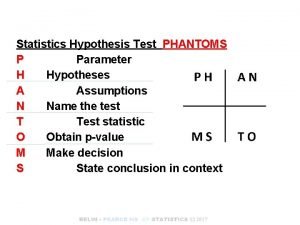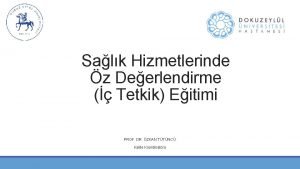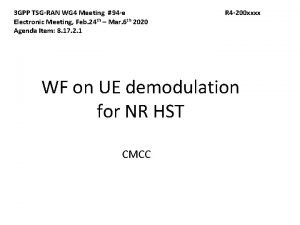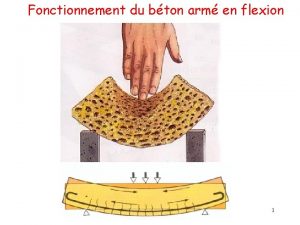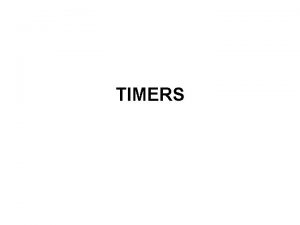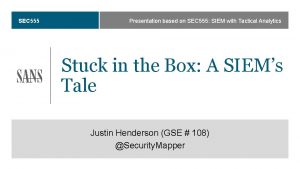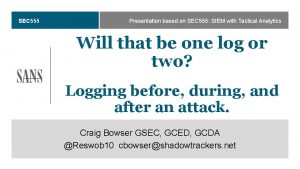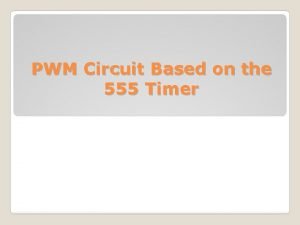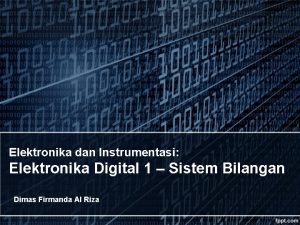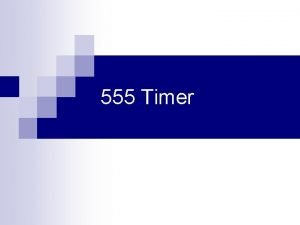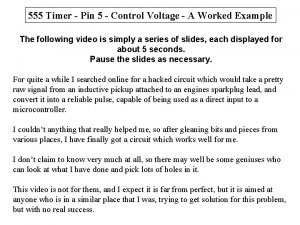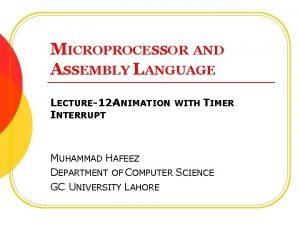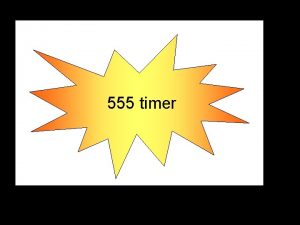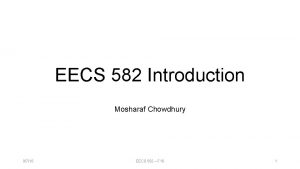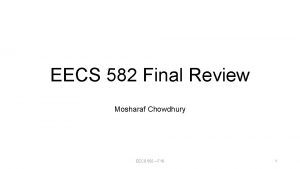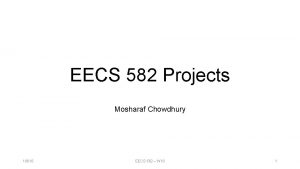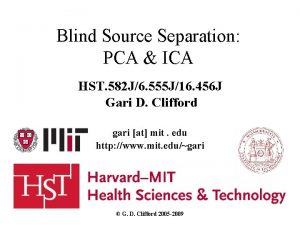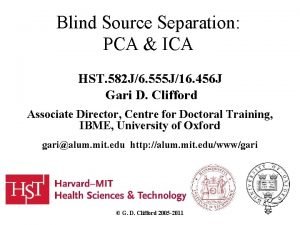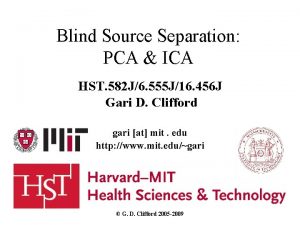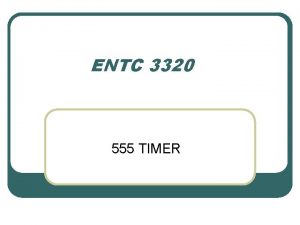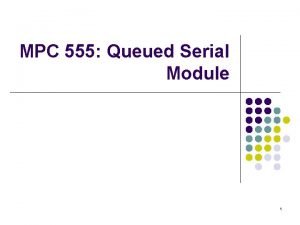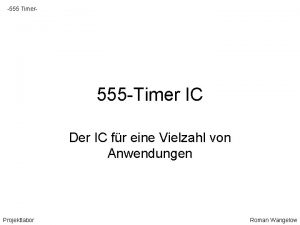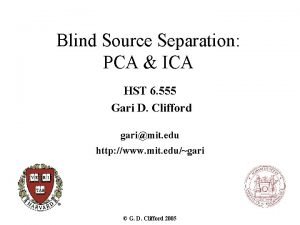HST 582 6 555 Image Processing II 2
















































- Slides: 48

HST 582 / 6. 555 Image Processing II

2 D and 3 D Image Processing • Useful linear signal processing for medical images – Interpolation – Down sampling – Hierarchical filtering – Computed Tomography (CT), • Projection Slice Theorem

2 D and 3 D Image Processing • Useful non-linear processing techniques – Histogram equalization – Homomorphic filtering – Gradient limited diffusion – Edge detection

Applications of Signal Processing in Medical Images • Linear signal processing – Image reconstruction (tomography, MRI) – Image enhancement – Noise reduction – Artifact reduction • Non-linear signal processing – Non-linear, adaptive filters • Tube enhancing filters

Interpolating Images • Why – Prepare synthetic multichannel data – Prepare data sets for parallel trips down the same processing pipeline

Interpolation • Optimal – Reconstruct the bandlimited original signal using sinc functions – Re-sample the reconstruction • Nearest Neighbor • Linear

Nearest Neighbor • Easy interpolator I 11 I 21 I 31 I 22 I 32 I 12 … … – To interpolate here, assign the intensity of the closest original pixel (in this case, I 11) – leads to blocky results

Linear Interpolator (1 D) f 2 f 1 0 f( T) = f 1 + T (f 2 - f 1) T 1

Bilinear Interpolator (2 D) • 2 D linear interpolator f 11 A f 21 C f 12 B use 1 D linear interpolation for A and B, use 1 D linear interpolation among A and B to get C • Similar for 3 D f 22

Bilinear Interpolator. . . T 1 f 11 A f 21 C f 12 B f 22 T 2 f( T 1, T 2) = f 11 + T 1 (f 21 - f 11) + T 2 (f 12 - f 11) + T 1 T 2 (f 22 - f 21 - f 12 + f 11)

Down Sampling • If you are lowpass filtering, maybe you can discard alternating pixels with losing too much • If you want to down-sample, maybe you should first do some lowpass filter to avoid aliasing – Reasonable LPF to use:

Burt (Peter) Filter image lowpass filter decimate by 2 ½ size image ¼ size image 1/ 8 size image

Projection Slice Theorem and CT x-rays Focus on one ray: (discrete) source … sensor photons leaving = An • photons entering

Continuous Analog. . . x is a log-attenuation-density called: Linear Attenuation Coefficient x(t 1, t 2) t 1 t 2 we can model x-ray imaging by line integrals…

Fourier Transform. . . x(t 1, t 2) Transform pairs xp(t 1) Transform pairs

CT Reconstruction using FT Methods • Rotate the x-ray apparatus to many angles – Take projections • FT the projections • Assemble the transformed projections in frequency space: – Get frequency data on these lines at the angles the projections were taken • Interpolate the full frequency space • Inverse FT to get back reconstruction There is a related method: Filtered Back-projection which is usually used

Linear and Non-Linear Processing for Medical Images Data Reconstruct image: usually linear image Improve image: maybe linear better image Segment, find surfaces: non-linear

Histogram Equalization • A method for automatically setting intensity lookup table • Apply a monotonic transformation to the data so that after the transformation, the result has a (nearly) uniform intensity histogram • Tends to increase contrast in areas where the data is concentrated

Histogram the Image Intensities Data Desired Histogram 0 Cumulative Data 255 Desired Cumulative 0 L A H 0 B 255

Histogram: Examples Image and its intensity histogram Histogram equalization From Lim

Homomorphic Filtering • An automatic method for spatially varying contrast adjustment <1 lowpass exp log highpass >1 H( ) ( 12+ 22)

Homomorphic Processing: Example Original image related: unsharp masking Image after homomorphic processing From Lim

Boundary Preserving Smoothers • “Gradient Limited Diffusion” –Malik & Perona – Currently the method of choice for postprocessing MRI before 3 D graphics.

Diffusion time • In GLD the diffusivity is moderated by the gradient magnitude, and the simulation is run for finite time.

Duality • Focus on regions Segmentation • Focus on boundaries Edges • Sometimes best to do both.

Edge Detection • From computer vision – Roberts – Horn – Marr and Hildreth – Canny Picture 1965 1972 1980 1983 Lincoln Lab MIT AI Higher Processor a compact description

Basic Idea: 1 D Edge • Motivation: ideal step edge + noise intensity this is the important information space 1 st find peak derivative space

Edges in 2 D profile • Strategy: – Find direction of gradient contour lines – Analyze derivative of signal in direction of gradients

Zero Crossing Style Edges: 1 D signal peak 1 st derivative 2 nd derivative Mark edges where 2 nd derivative = 0 (vigorously) zero crossing

Noise • Noise is an issue with derivative operators – How do we fight the noise • Assume white noise • Assume good stuff has important low frequency content • recall Wiener filtering. . .

Noise • Noise is an issue with derivative operators – How do we fight the noise • Assume white noise • Assume good stuff has important low frequency content • USE LOWPASS FILTER (Gaussian ? )

Difference of Gaussians Gaussian Blur signal 2 nd Derivative + mark zero crossings

Works in 2 D, 3 D, … • Gaussian separates • There exists a rotationally-symmetric 2 nd derivative operator: Laplacian similar for 3 D Discrete analog: -1 -1 -1 8 -1 -1 -1

2 D 2 G Operator • The zero crossing contours of the result of an operator like this form closed contours. “Mexican hat”

Seminal Edge References. . . • “Theory of Edge Detection”, David Marr, Ellen Hildreth, Proc. Royal Statistical Society of London, B, vol 207, pp 187 -217, 1980 – good paper, often cited • VISION, David Marr – good book!

Threshold Bug • Excess zero crossings from noise, etc. – Usual fix: threshold edges based on “strength. ”

Edge Detection In 2 D: threshold based on gradient strength signal big 1 st derivative magnitude 1 st derivative 2 nd derivative “strong” zero crossing

(Pen)ultimate Edge Operator Canny • For improved noise behavior go back to 1 D directional derivatives • For less fragmentation – Use Hysteresis thresholding • The problem: edge fragmentation

In 1 D Along 2 D Contour threshold edge strength

Schmidt Trigger uses Hysteresis High threshold Low Threshold edge strength

John Canny MIT MS Thesis

Edge Detection: Example Original image

Edge Detection: Example Detected edges

Edges in 3 D are Surfaces • Somewhat useful for finding organ boundaries (e. g. in CT). – Simple. – May leave the problem of figuring out which boundary is what.

3 D Medical Edge Finding. . . • Recursive Filtering and Edge Tracking: Two Primary Tools for 3 D Edge Detection – Olivier Monga, Rachid Deriche, Gergoire Malandain, Jean Pierre Cocquerez – Image and Vision Computing Vol 9, Nr. 4, 1991



the end.
 Hst image
Hst image High boost filtering matlab
High boost filtering matlab Point processing in image enhancement
Point processing in image enhancement Histogram processing in digital image processing
Histogram processing in digital image processing Laplacian filter
Laplacian filter Point processing
Point processing Digital image processing
Digital image processing Experiment 582
Experiment 582 582 605
582 605 Eecs 582 umich
Eecs 582 umich Eecs 582
Eecs 582 Eecs 370 curve
Eecs 370 curve Find the percentage decrease from 490 to 343
Find the percentage decrease from 490 to 343 Eecs 582
Eecs 582 Phantoms in statistics
Phantoms in statistics Translate
Translate Optimum notch filter in image processing
Optimum notch filter in image processing Spatial and temporal redundancy in digital image processing
Spatial and temporal redundancy in digital image processing Image segmentation in digital image processing
Image segmentation in digital image processing Error free compression
Error free compression Image sharpening and restoration
Image sharpening and restoration Image geometry in digital image processing
Image geometry in digital image processing Digital image processing diagram
Digital image processing diagram Digital image processing
Digital image processing Image geometry in digital image processing
Image geometry in digital image processing Noise
Noise Dehis.hst
Dehis.hst Hst-sfn
Hst-sfn Mexican hst
Mexican hst Hrvatski sindikat telekomunikacija
Hrvatski sindikat telekomunikacija Hst realview
Hst realview Top down procesing
Top down procesing Gloria suarez
Gloria suarez Bottom up and top down processing
Bottom up and top down processing Examples of secondary processing
Examples of secondary processing Parallel processing vs concurrent processing
Parallel processing vs concurrent processing Top down processing
Top down processing Batch processing and interactive processing
Batch processing and interactive processing 555 bistable circuit
555 bistable circuit Time speed distance formulas
Time speed distance formulas Sec555
Sec555 Sec 555
Sec 555 555 timer pwm circuit
555 timer pwm circuit Fire fighting methods
Fire fighting methods Artinya 444 555 666 888 33 88
Artinya 444 555 666 888 33 88 555 timer ic pin configuration
555 timer ic pin configuration Control voltage in 555 timer
Control voltage in 555 timer Timer in digital electronics
Timer in digital electronics 555 timer animation
555 timer animation
